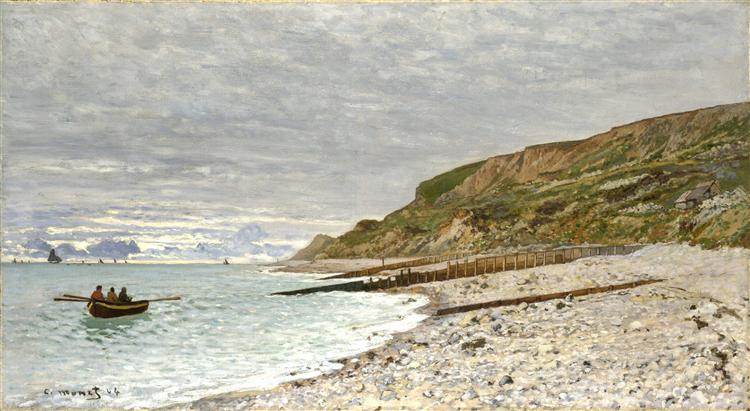Description
Claude Monet's painting "La Pointe de Heve" created in 1864 is a work that encapsulates the essence of the Impressionist movement and provides a profound insight into the relationship between light and landscape. Monet, one of the founders of Impressionism, seeks in this piece to capture a scene of the Normandy coast with his signature focus on changing light and atmosphere. The work shows a view of the cliff of Heve in the Normandy region, suggesting a quest not only for the depiction of the natural environment, but also for the viewer's emotional interaction with it.
The composition of the work is dynamic and swinging, marked by the undulations of the sea and the subtlety of the clouds. Monet uses loose, rapid brushstrokes, suggesting the movement of waves and the sea breeze. This technique highlights the immediacy of the moment and allows the viewer to immerse themselves in the atmosphere of the landscape, almost as if they were present in the scene. The arrangement of the horizon, which cuts the work in a diagonal line, also adds a sense of depth and dimension, guiding the viewer's gaze from the water to the sky and back again.
In terms of color, Monet uses a palette of blues, grays, and greens that evokes the freshness of the sea. The fusion of these colors, along with the yellow hues and hints of white in the clouds and ocean foam, creates a sense of light that will saturate the image with life and energy. The use of soft light, often seen in Monet's works, suggests a time of day when the light is most sublime, conveying a sense of tranquility, but at the same time, a slight drama that occurs in nature.
In "La Pointe de Heve", there are no human figures to direct the viewer's attention; the scene is focused on the landscape itself, giving it an air of solitude and contemplation. This is characteristic of Monet's approach, who often eschewed the inclusion of figures in favour of a deeper exploration of the effects of light and colour on the natural environment. The absence of figures invites the viewer to reflect on their own existence in relation to the vast nature around them.
Although this work is not as well-known as some of his other creations, such as Impression, Sunrise, it is a testament to the early development of the Impressionist style that Monet was beginning to explore at this stage in his life. Pointe de Heve stands as a precursor to the works to come, which would continue to be noted for their focus on perception and visual experience rather than literal representation. When viewing this work, the viewer can sense the transition from a more academic approach to one that advocates free interpretation of naturalism, highlighting Monet's evolution as an artist.
In conclusion, Claude Monet's "La Pointe de Heve" is not just a representation of nature, but an artistic exercise that reflects the concerns and experiments of a master in his quest to capture the ephemeral essences of the world around him. The work is a fascinating example of how Impressionism begins to take its first steps, a legacy that would continue to influence generations of later artists.
KUADROS ©, a famous painting on your wall.
Hand-made oil painting reproductions, with the quality of professional artists and the distinctive seal of KUADROS ©.
Painting reproduction service with satisfaction guarantee. If you are not completely satisfied with the replica of your painting, we will refund 100% of your money.

